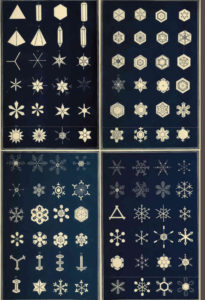Snowflakes
Job 38:22
“Hast thou entered into the treasures of the snow? or hast thou seen the treasures of the hail,”
 As I write this particular Creation Moment, the weather in Washington state is very wintry. The falling snow has been a constant source of conversation. Are the roads going to be clear, or will they be dangerous for driving? Will outdoor faucets freeze, and what can we do to protect them? And are the schools closing today?
As I write this particular Creation Moment, the weather in Washington state is very wintry. The falling snow has been a constant source of conversation. Are the roads going to be clear, or will they be dangerous for driving? Will outdoor faucets freeze, and what can we do to protect them? And are the schools closing today?
Coupled with these conversations will be the usual comment that no two snowflakes are the same shape.
Now, we cannot prove that this common assertion is true. Snowflakes frequently, though not always, grow in a hexagonal manner, and this is because of the hexagonal arrangement of water molecules in an ice crystal. But the great variation seen in snowflakes cannot be proved beyond doubt to be unique. Even if it is not unique, however, the chances of finding two identical snowflakes in any given fall of snow seems to be very remote, so uniqueness of design, while not absolute, is certainly sufficient to give pause for thought.
Snowflakes are formed when tiny water droplets form crystals around particles of dust. The actual shape of the snowflake seems to depend on weather conditions, such as temperature and humidity. If the air is fairly humid, and above -40ºC (-40ºF), then the snowflake formation is at its best, as far as the attractiveness and variety of design is concerned.
Whether or not snowflakes are unique, they certainly give us good reason to stop and consider the greatness of God, who has made everything so well. Author: Paul F. Taylor
Prayer: Thank You, Lord, for the beauty of Your creation. Thank You for the beauty seen in the treasures of snow. We praise Your Name for all that You have done. Amen.
Ref: Encyclopaedia Britannica, < https://www.britannica.com/science/snow-weather >, accessed 2/24/2018. Image: Israel Perkins Warren, 1863, classification of snowflakes, Public Domain.